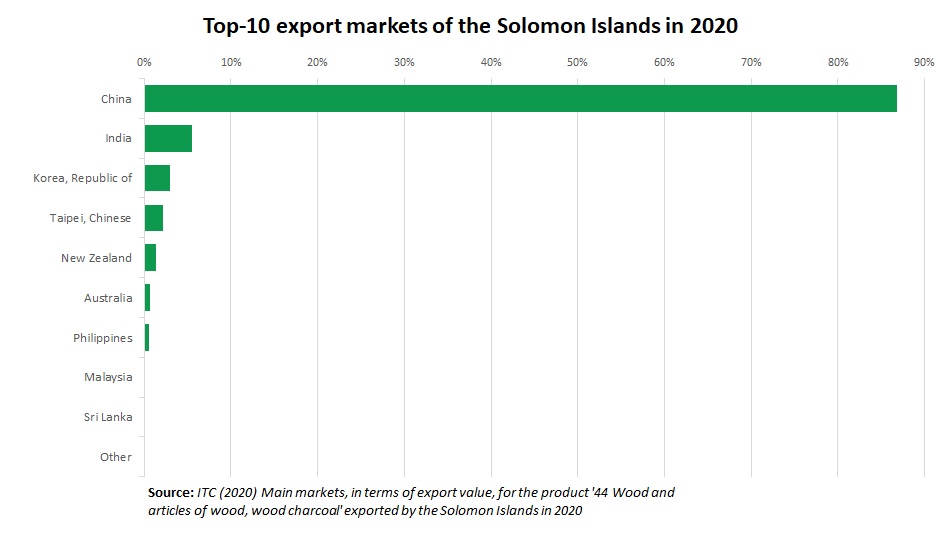Overview of timber sector of Solomon Islands
Supply chain actors
The main actors holding the rights to harvest are logging companies, milling licence holders, and various local timber associations. Logging companies transport logs to log ponds and onto log ships for direct export, whilst timber suppliers transport sawn timbers by boat or trucks to timber milling companies who then process it for domestic sale and export. Timber milling companies own processing plants and are the principal buyers/traders of logging companies and local forest owners, as well as the main suppliers to timber exporters.
Production and processing
Main harvested species
Primary timber species exported as sawn timber include: vitex (Vitex cofassus), akwa or taun (Pometia pinnata), kwila or merbau, (Intsia bijuga) and rosewood (Pterocarpus indicus).
Major species exported as round log are: Callophyllum spp, Pometia pinnate, Terminalia brassi, Palaquim, Dillenia spp, Celtis spp, Burkella spp, Dysoxyllum spp and others.
In the past, the timber industry in the Solomon Islands was dominated by large scale milling operations using fixed base band and circular saws. Recently, the use of portable chainsaws and Lucas milling is more common. Varying levels of mechanization are used in timber extraction depending on the scale of the operation, ranging from carrying timber by hand, to the use of heavy machinery.
Timber milling companies either receive logs from logging companies or from local timber suppliers in the form of wood in rough and sell locally as well as export to overseas markets. The main processed wood products are: wood in rough, wood sawn chipped lengthwise, and sheets of veneer.
There is no proper detailed monitoring of timber production in the provinces due to lack of record management by the Ministry of Forest and Research. This is the same with timber milling companies in the provinces.
Export
The forestry sector is a major single export revenue source and through export duty contributes 60-70% of the total export revenue of the national economy. In 2016 and 2017, around 65% of the country’s export earnings came from forestry, mainly through sale of round logs, sawn timber and veneer which accounts for 20% of the state revenue (Central Bank of Solomon Islands, 2017).
In 2017 export destinations for round logs were: China (87%), India (5%), Vietnam (2%), Taiwan and Korea (1%). Sawn timber was exported in that year mostly to New Zealand (43%) and Australia (33%), whilst veneer was exported mostly to Taiwan and South Korea(Ministry of Forestry and Research Annual Report, 2016-2019).
Solomon Islands timbers are popular on the New Zealand and Australian markets. This is expected to remain so as long as perceptions surrounding issues sustainability and legality are unambiguous.

Logistics infrastructure
Currently, Solomon Islands has only two international seaports in which timber is exported from in the country, which are Honiara international seaport located in Guadalcanal province, and Noro international seaport located, in Western province. Most timber is exported from Honiara as this is where the larger timber milling companies are based. The Noro seaport is mostly responsible for clearance purposes. Both facilities serve the same export destinations. The Solomon Islands Government is in the process of establishing an additional international seaport in Malaita Province, one of the highest populated provinces in the country.
Data table
| Production (X 1000m3) |
Imports (X 1000m3) |
Domestic consumption (X 1000m3) |
Exports (X 1000m3) |
|
|---|---|---|---|---|
| logs | 2.360 | 0 | 176 | 2.184 |
| Sawnwood | 31 | 0 | 21 | 10 |
| Veneer | 32 | 0 | 14 | 18 |
| Plywood | 0 | 1 | 1 | 0 |
ITTO (2019), data 2017


